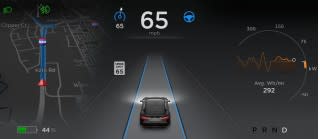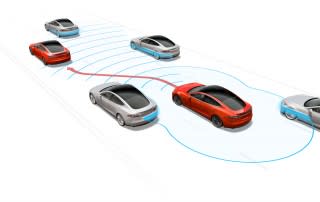Old Vs New: 2016 Tesla Model S 90D Compared To Original Version
![2016 Tesla Model S 90D during Southern California test drive [photo: David Noland]](https://s.yimg.com/ny/api/res/1.2/bKWU0zXZUm_aKmsy9Kk.6w--/YXBwaWQ9aGlnaGxhbmRlcjt3PTY0MDtoPTQ4MA--/https://s.yimg.com/os/en_US/Autos/GreenCarReports/2016-tesla-model-s-90d-during-southern-california-test-drive-photo-david-noland_100545570_s.jpg)
In a week or so, my 2013 Tesla Model S, now fitted with an 85-kilowatt-hour battery, will wind up its third year of residence in my driveway.
It just finished its third cross-country trip, from my home in New York’s Hudson Valley to a winter getaway in Carpinteria, California, and the odometer just ticked over 55,000 miles.
It’s been a great ride. Though my battery capacity has declined about 7 percent, reducing my range from 265 miles to 248, the car still looks and drives like new, and I still tingle every time I get in it.
Not once have I looked out through the windshield and said to myself, “I wish I were driving that car instead of this one.”
DON'T MISS: Tesla Model 3 Unveil On March 31, Deposits Accepted That Day
Until last week.
I’d dropped by the Tesla store in Santa Barbara to see about replacing my worn-out Michelin Primacy tires. A sales guy asked about my car’s age and mileage, and suggested that now would be a great time to trade in my three-year-old car on a new Model S.
“We’re really looking for CPO cars,” he told me, referring to Tesla’s Certified Previously Owned program.
“We could give you a good trade-in allowance for yours right now," he said. "But 60,000 miles is the upper limit for a CPO car, so once you get past that number, the trade-in value would go way down.”
He pointed at a gorgeous 2016 metallic blue S90D parked in front of the showroom. “If you’d like to test-drive that one, I could let you have it for 24 hours.”
![2016 Tesla Model S 90D during Southern California test drive [photo: David Noland]](https://s.yimg.com/ny/api/res/1.2/SZrGAL6bzLhIuRF3eI8.Hg--/YXBwaWQ9aGlnaGxhbmRlcjt3PTY0MDtoPTQ4MA--/https://s.yimg.com/os/en_US/Autos/GreenCarReports/2016-tesla-model-s-90d-during-southern-california-test-drive-photo-david-noland_100545568_s.jpg)
Deal! We traded keys, and I drove off in the 90D.
At the time, I figured there was zero chance of me doing a $40-50,000 trade-up just to get the latest model. (Sorry, sales guy.)
But I was eager to see how the Model S has evolved over the past three years.
No more 85
As I write this, Tesla has just discontinued the 85-kWh Model S. Its replacement, the 90-kWh version, is now available only with the dual motors that give it all-wheel drive.
ALSO SEE: Tesla Model 3: What We Know About Its $35,000, 200-Mile Electric Car
So the 90D is in fact the closest current equivalent to my 2013 S85, and the appropriate model for a then-versus-now comparison.
My car, with air suspension, 19-inch wheels, and no sunroof, had a list price of about $81,000 in 2013.
An equivalent 2016 90D, similarly equipped, would price out at $91,500 today. About half the difference is the cost of the dual-motor set-up; the other half is a combination of a 2014 price increase and some minor changes to standard equipment.
![2016 Tesla Model S 90D during Southern California test drive [photo: David Noland]](https://s.yimg.com/ny/api/res/1.2/.z0bvQKjyjPJX_W3XA3XmA--/YXBwaWQ9aGlnaGxhbmRlcjt3PTY0MDtoPTQ4MA--/https://s.yimg.com/os/en_US/Autos/GreenCarReports/2016-tesla-model-s-90d-during-southern-california-test-drive-photo-david-noland_100545569_s.jpg)
Better acceleration
The first revelation came almost immediately, as I pulled onto the 101 freeway. The 90D definitely feels quicker off the line.
My 85 has a listed 0-to-60-mph time of 5.2 seconds. The 90D’s official number is 4.2 seconds.
That’s a big difference on paper, but I’d always wondered how the lower number translated into real-world use.
READ THIS: Life With Tesla Model S: Service Centers Get Crowded, Cost More
It translates very well indeed: the 90D is noticeably, grin-inducingly quicker than my 85.
In fact, I’d call the 90D’s acceleration almost perfect: It's all you ever need for normal driving, plus a little bit extra just for the fun of it.
Anything more—like the over-the-top acceleration of the Model S Performance versions—seems to me good only for bragging rights, street racing, and scaring the pants off passengers.
Not that there’s anything wrong with that, but those aren't my priorities.
Better handling
I’m not the type of driver who screeches around curves on mountain roads, so I’m not particularly qualified to comment about on-the-edge handling for either car.
![2016 Tesla Model S 90D during Southern California test drive [photo: David Noland]](https://s.yimg.com/ny/api/res/1.2/bKWU0zXZUm_aKmsy9Kk.6w--/YXBwaWQ9aGlnaGxhbmRlcjt3PTY0MDtoPTQ4MA--/https://s.yimg.com/os/en_US/Autos/GreenCarReports/2016-tesla-model-s-90d-during-southern-california-test-drive-photo-david-noland_100545570_s.jpg)
The only deficiency I’ve noted in my rear-drive 85 is a tendency to lose traction briefly and fishtail a bit when I accelerate hard into a sharp turn: entering a busy major road from a side road or parking lot, for example. And it’s especially noticeable on wet pavement.
I tried this maneuver a couple of times with the 90D (on dry pavement), and it was clearly superior. No hint of a fishtail.
Winter traction
I’ve found the winter traction of my 85 to be mediocre, at least with mid-life all-season tires.
Yes, the vaunted traction control works fine, but all that means is that the car stops moving up the gentle grade in my driveway before it spins its tires.
CHECK OUT: Is Chevy Bolt EV's Main Mission To Marginalize Tesla Electric Cars?
There was no snow available in Southern California for a winter traction comparison. (Damn!)
But I think it’s safe to assume that the 90D would be vastly superior to my 85 in this regard.
Autopilot
Autopilot is all the rage in Teslaworld these days. (Head-snapping acceleration and that 100-MPGe efficiency are so 2014....)
My 90D tester was of course enabled with the Autopilot software, a $2,500 option.
After three years of perfectly satisfactory cruise control in my 85, I was eager to see what all the shouting was about. And as a former private pilot who used autopilots in small planes at every opportunity, I wanted to see how the autopilot concept translated to the ground.

Unfortunately, Tesla’s Autopilot and I got off to a bad start.
By coincidence, I first engaged it just before a section of Highway 101 where the lane-divider lines are poorly painted and the grooves between the slabs of concrete are particularly conspicuous.
I double-flipped the autopilot control to engage it and let go of the wheel. The car beeped softly, the lane lines depicted on the instrument panel turned blue, and the car began steering itself.
But within a few hundred feet, the painted lane lines on the highway diverged from the concrete grooves. Apparently confusing the two, the car abruptly swerved halfway into the next lane before I could stop it.
Five seconds after I’d turned it on, Autopilot had scared the [obscenity] out of me.
Fortunately, there was no car in the next lane, or I might have learned about the outer limits of my insurance coverage.
With better lane markings, Autopilot performed well during my subsequent tests. As advertised, it stayed in its assigned lane and followed the traffic ahead by whatever distance I commanded.

But I found that the car couldn’t figure out what to do when driving in a right-hand lane that ended, when traffic was supposed to merge left. After a couple of aimless darts back and forth, a quick driver takeover was again required.
If I left my hands off the wheel for too long, the car would remind me to put them back. But just the right touch was required.
Too gently, and it didn’t feel the touch. Too firmly—when combined with a slight pressure right or left—and it would interpret the move as an attempt to overpower it, and shut off automatically.
As a result, there were a couple of times where I wasn’t quite sure which one of us was driving, me or the car.
My experience is apparently not unusual; Car and Driver magazine recently tested the Model S autopilot system (along with those of three other luxury cars), and noted 29 “lane control interruptions” along its 50-mile test route.
Amazingly, that was far better than the competing Mercedes, BMW, and Infiniti systems, which registered anywhere from 56 to 93 hiccups along the way.

In the end, I found that all the commanding and monitoring of Autopilot was actually more mentally taxing than driving. Ironically, for me the sigh of relief and feeling of relaxation came when I turned Autopilot off and took over the wheel myself.

 Yahoo Autos
Yahoo Autos 
